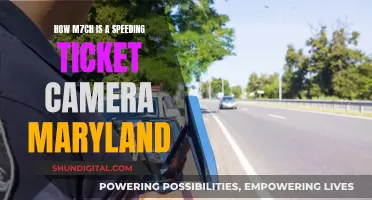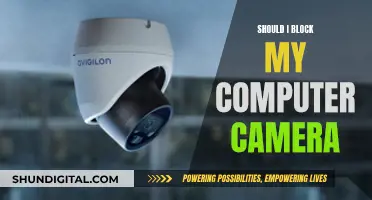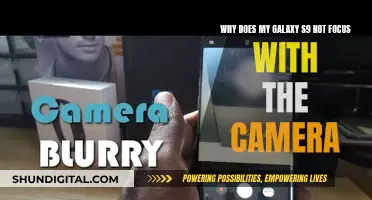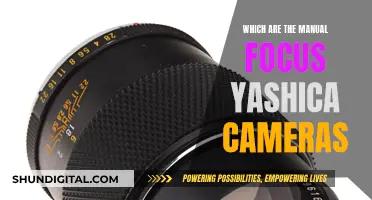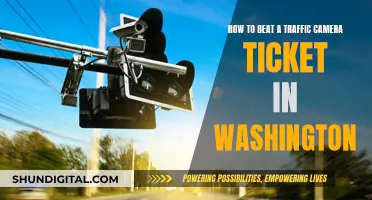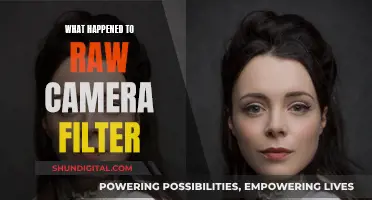
Surveillance cameras played a crucial role in the hunt for the Boston Marathon bombers. The FBI released photos and video footage of two suspects, which led to their identification. Video evidence was compiled from government surveillance cameras, private security cameras, and footage shot by bystanders on smartphones. This mountain of footage was critical in the investigation, leading to the identification and arrest of the Tsarnaev brothers. The use of surveillance cameras in this case sparked debates about privacy and security, with some arguing for more cameras in public spaces to improve security, while others raised concerns about the potential for abuse and the intrusive nature of constant monitoring.
| Characteristics | Values |
|---|---|
| Surveillance camera footage | Used to identify the Boston Marathon bombers |
| Footage from privately-owned cameras along the marathon route gave the FBI early clues about the suspects | |
| Surveillance camera footage was also used in the prosecution of 19-year-old Dzhokhar Tsarnaev | |
| A Lord and Taylor department store security camera provided video of one of the suspects dropping his backpack at the spot of the bombing | |
| Surveillance cameras were also used to identify the London subway bombers in 2005 | |
| Surveillance videos captured the Tucson shootings in 2011 | |
| Surveillance cameras are now equipped with facial recognition software | |
| Boston had an estimated 55 CCTV cameras set up around the city in 2007 | |
| Boston's surveillance system has expanded since 2007, but authorities have not commented on the exact scope of the current setup |
What You'll Learn

Surveillance cameras helped identify the Boston bombers
Surveillance cameras played a pivotal role in identifying the Boston Marathon bombers and bringing them to justice. The FBI relied on footage from government surveillance cameras, private security cameras, and images shot by bystanders on smartphones to identify the suspects and build a criminal case.
One of the most crucial pieces of evidence came from a Lord and Taylor department store security camera, which captured one of the suspects dropping his backpack at the scene of the bombing. This video evidence, along with photos and videos taken before and after the blasts, helped authorities zero in on the Tsarnaev brothers as the prime suspects.
The use of surveillance cameras in the Boston Marathon bombing investigation highlights the growing reliance on video evidence in solving crimes. According to forensic video analyst Grant Fredericks, "Video holds more evidence than any other source: more than DNA, crime-scene analysis or eyewitness testimony." The vast network of surveillance cameras in Boston, including those on the marathon route, played a critical role in capturing vital footage of the suspects.
While the use of surveillance cameras in public spaces raises important privacy concerns, many argue that the benefits of these cameras in ensuring public safety outweigh the risks. Proponents of surveillance cameras point to their effectiveness in solving crimes and argue that they are a less intrusive security measure compared to alternatives such as pat-downs and metal detectors.
In the aftermath of the Boston Marathon bombing, there have been calls for even more surveillance cameras in public spaces, with the belief that a larger network of cameras could help prevent similar incidents in the future. However, it is important to note that the effectiveness of surveillance cameras in crime prevention is still debated, and there are ongoing discussions about striking the right balance between security and privacy.
Understanding Camera Batteries: Powering Your Photography
You may want to see also

Cameras were placed by the police and private businesses
Surveillance cameras played a crucial role in the hunt for the Boston Marathon bombers. The police and private businesses had placed cameras in the area, and footage from these cameras gave the FBI early clues about the suspects.
Since 9/11, law enforcement agencies have used federal grants to buy surveillance cameras for areas across the country that are plagued by crime or potentially targeted for terrorism. A 2007 count stated that downtown Boston was watched by a network of at least 147 police surveillance cameras. On the marathon route, it is likely that most businesses had surveillance cameras, along with every ATM and red-light traffic device with a license plate reader.
The Boston Police Department had also installed temporary video cameras along the route of the Boston Marathon, some of which became a permanent part of the city's surveillance network. High-definition video cameras with 30x magnification were placed to keep watch over the Boston Marathon finish line, where two bombs detonated in 2013, killing three people and injuring hundreds.
The best piece of evidence may have come from a Lord and Taylor department store security camera, which provided video of one of the suspects dropping his backpack at the spot of the bombing. The FBI released blurry shots of the two suspects, taken by this department store's cameras, just three days after the bombing.
The proliferation of cameras in America's big cities raises questions about the balance between security and privacy. While some people feel more secure knowing that surveillance cameras are in place, privacy advocates and other citizens are uneasy with the idea that their every public move is being monitored.
Mastering the Art of Focusing Your Rangefinder Camera
You may want to see also

The FBI compiled footage from various sources
The Boston Marathon bombing was a devastating act of domestic terrorism that left three dead and hundreds injured. In the aftermath of the attack, the FBI played a crucial role in compiling and analysing footage from various sources to identify the perpetrators.
The FBI's efforts to identify the suspects began with the release of images and videos of two suspects carrying backpacks near the finish line of the Boston Marathon. These images were obtained from a variety of sources, including government surveillance cameras, private security cameras, and footage shot by bystanders on their smartphones. The public responded to the release of these images by sending a large volume of photographs and videos to the authorities.
One key piece of evidence was a surveillance video from a department store, Lord & Taylor, in Copley Square. This video showed a man leaving a bag at the scene of the crime, which was a significant breakthrough in the investigation. The FBI also utilised facial recognition software and analysed cell phone records to identify the suspects.
The FBI's analysis of the footage, in collaboration with other law enforcement agencies, led to the identification of the Tsarnaev brothers as the suspects. The brothers were eventually located and apprehended, with one brother dying during the manhunt and the other being taken into custody and sentenced to death.
The use of surveillance footage in the Boston Marathon bombing investigation highlights the increasing reliance on video evidence in solving crimes. While it provides valuable information, the vast amount of footage can also be overwhelming and time-consuming to sift through. This case demonstrates the critical role that video evidence and technological advancements play in identifying and apprehending suspects in complex investigations.
The Evolution of Cameras: From First Invention to Now
You may want to see also

Cameras are now commonplace in major cities
The Boston Marathon bombers were identified with the help of security-camera footage. In the wake of the 9/11 terrorist attacks, law enforcement agencies have used federal grants to buy surveillance cameras for areas across the United States that are plagued by crime or potentially targeted for terrorism.
The use of surveillance cameras in public spaces is commonplace in major cities. Cities such as New York and London now have thousands of cameras on their streets. London's "Ring of Steel" surveillance system, set up in 1998, combines nearly half a million cameras, roadblocks, and license plate readers to monitor the heart of the city. Modeled after London's system, New York's Lower Manhattan Security Initiative monitors 4,000 security cameras and license plate readers.
In 2019, it was predicted that there would be 1 billion surveillance cameras worldwide by the end of 2021. Cities in China are under the heaviest CCTV surveillance in the world, with an estimated 626 million cameras within the country. Beijing, China's capital city, has the most cameras overall, with a total of 1.15 million installed.
Outside of China, the top 10 most surveilled cities are Hyderabad, Indore, Delhi, Singapore, Moscow, Baghdad, Seoul, St. Petersburg, London, and Los Angeles.
The use of facial recognition technology is also growing in cities. Several U.S. cities, including Boston, have banned the use of facial recognition technology by police and city agencies due to concerns over privacy. However, civil liberties activists are concerned about how this technology could be abused if databases from different cities or sources are connected.
While some people feel more secure knowing that surveillance cameras are in place, privacy advocates and other citizens are uneasy with the idea of being monitored in public spaces.
The Most Priceless Camera Ever Made
You may want to see also

Privacy concerns have been raised by civil liberties groups
The use of surveillance cameras to identify the Boston bombers raised concerns among civil liberties groups. While many acknowledged the value of video evidence in identifying the Tsarnaev brothers, there were worries about the broader privacy implications of mass surveillance.
The American Civil Liberties Union (ACLU) noted that the public spaces of Boston were already filled with enough private cameras to identify the suspects, and questioned the need for additional public cameras. They argued that ubiquitous public cameras watched by officials raise concerns of criminal abuse, institutional abuse, personal abuse, discrimination, and rampant voyeurism.
The ACLU also pointed out the lack of data retention policies for many police departments, with videos likely to be stored permanently in cases that may result in the death penalty. This raises concerns about the indefinite storage of video evidence in databases without clear rules for how it can be used.
Civil liberties activists are particularly concerned about the potential for abuse with the increasing use of facial recognition software and other technologies that can automatically mine surveillance footage. This technology can track people's movements across states or continents, raising concerns about the potential for tracking individuals attending political protests, for example.
In addition, there are worries about the misidentification of suspects, as these systems are not perfect and can make mistakes. The effectiveness of mass surveillance in preventing crimes has also been questioned, with some arguing that it may not be a deterrent for criminals.
The expansion of surveillance networks in cities like Boston has led to a search for a balance between public security and personal liberty. While some argue for more cameras to improve safety, civil liberties groups caution against the potential erosion of privacy and the risk of abuse of power by authorities.
Choosing the Right Batteries for Your Kodak Camera
You may want to see also
Frequently asked questions
The suspects of the Boston Marathon bombing were identified using security-camera footage, smartphone pictures from the public, and forward-looking infrared cameras. The best piece of evidence came from a Lord and Taylor department store security camera, which showed one of the suspects, Dzhokhar Tsarnaev, dropping his backpack at the spot of the bombing.
Surveillance cameras played a crucial role in identifying the Boston Marathon bombers. Video evidence was compiled from various sources, including government surveillance cameras, private security cameras, and footage shot by bystanders on smartphones. This allowed investigators to piece together the movements of the suspects before and after the bombing.
Surveillance cameras can help prevent crimes, not just solve them. They act as a deterrent and can provide real-time monitoring, allowing authorities to respond quickly to incidents. Additionally, with advancements in technology, artificial intelligence and facial recognition software can be used to analyze footage and identify suspects more efficiently.


